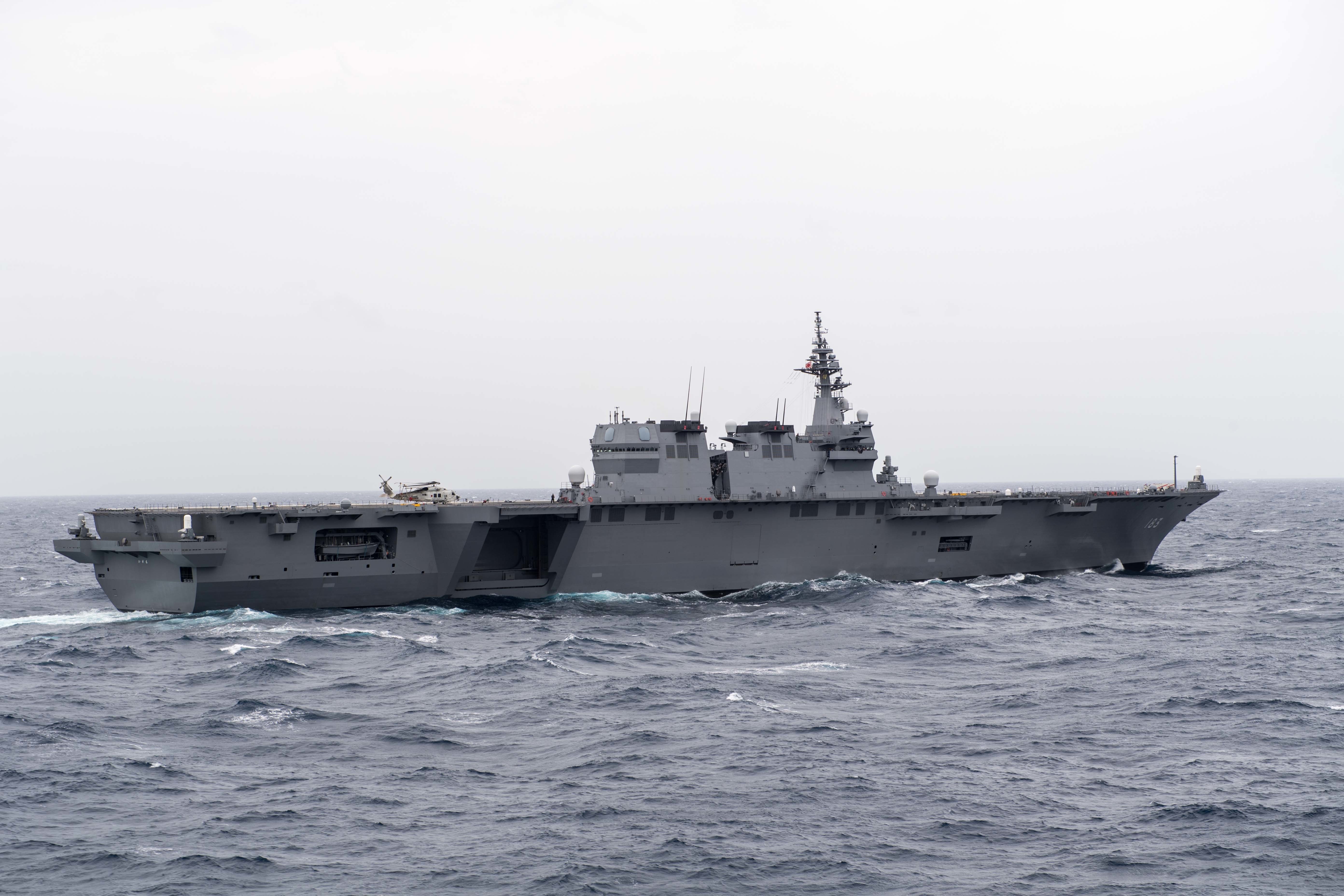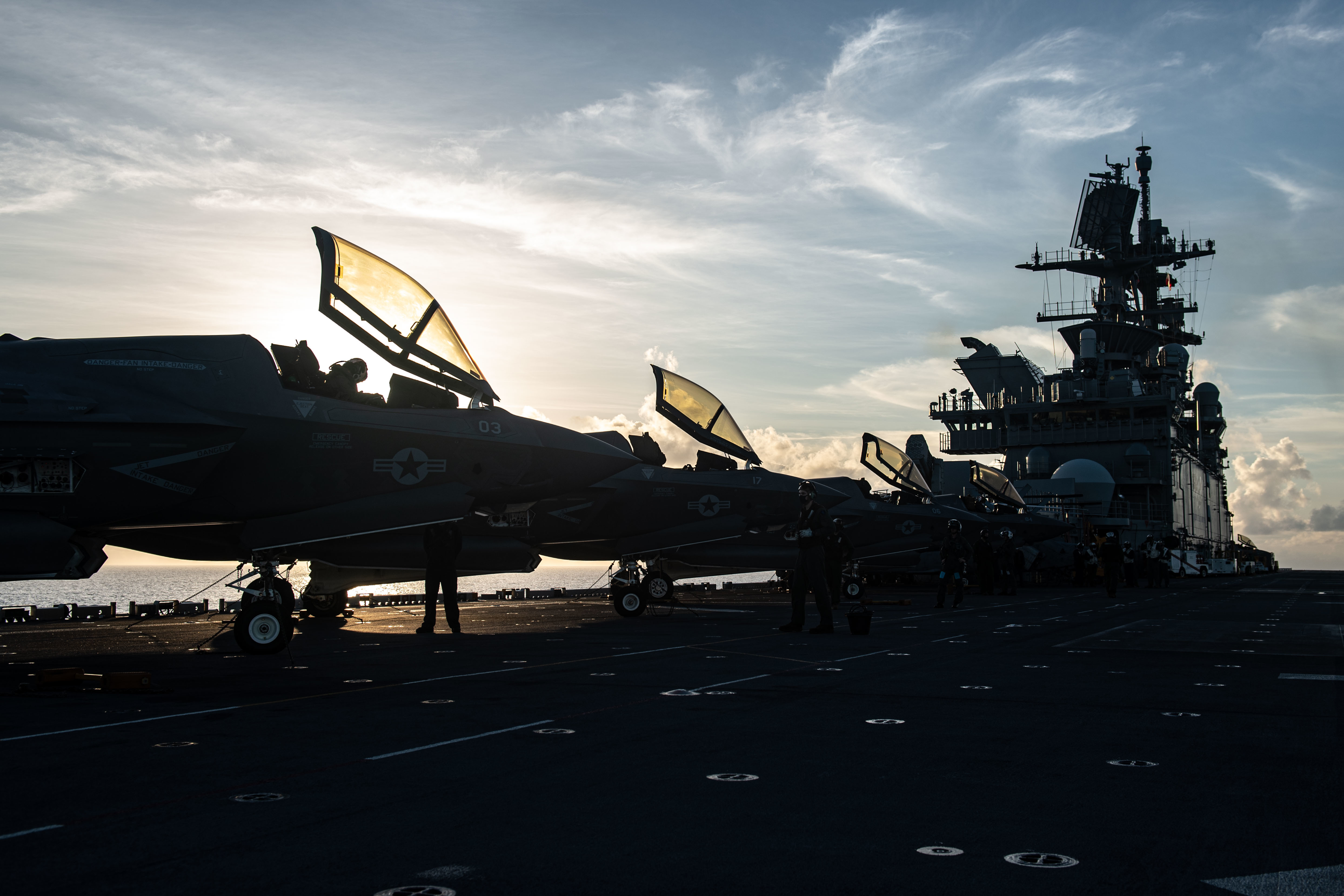
KUALA LUMPUR – U.S Marine F-35Bs from Iwakuni will support the Japan Maritime Self-Defense Force’s post refit trials of the destroyer helicopter carrier JS Izumo (DDH183) next month.
The Marine Corps aircraft will work with the JMSDF in the Pacific Ocean from Oct. 3 through Oct. 7, according to a Thursday news release from the Japan Defense Ministry. Izumo in June completed the first of a two-stage modification that will enable it to operate the F-35, with the first stage adding heat resistant coating to the flight deck and flight line markings for F-35 operations.
The release did not say which squadron the aircraft would come from or how many USMC F-35Bs will be embarked for the trials. The U.S. Marines have two F-35B squadrons operating from Marine Corps Air Station Iwakuni, with the “Bats” of Marine Corps Fighter Attack Squadron (VMFA) 242 declaring initial operating capability on Sept. 9. The other squadron – the “Green Knights” of VMFA-121 – reached IOC in July 2015, before deploying to Japan in January 2017.
MCAS Iwakuni detailed Izumo arriving to the base’s harbour in a Thursday new release, though it did not state the purpose of the ship’s arrival.
USNI News reported on Sept. 1 that Marine Corps Commandant Gen. David Berger said U.S Marine F-35s would operate off a Japanese warship later this year, though it is unclear whether he meant the trials or a later operational or exercise deployment on Izumo.
Izumo’s final conversion work will be carried out in Fiscal Year 2025, while its sister ship – JS Kaga (DDH184) – will be fully modified in FY 2022. The second stage of Izumo’s conversion and the full stage of Kaga’s conversion will involve a change of the shape of the ships’ bows along with interior reconfiguration allowing them to embark and fully operate F-35s.

The modification of Izumo and Kaga are paired with a planned Japan Self-Defense Forces buy of 42 F-35Bs to operate from the two ships. The first of the JSDF F-35Bs are set to arrive in FY 2023 and the U.S. Marine F-35s are expected to continue operating off the two ships as Japan acclimates itself to operating F-35Bs. The JMSDF has already conducted a series of engagements and exchanges in relation to F-35B operations with the U.K. Royal Navy’s Carrier Strike Group 21 (CSG21) while it was in Japan in early September.
A JMSDF submarine carried out a series of anti-submarine warfare training from Sept. 14 to 15 with a Royal Navy submarine near Japan, the JMSDF said in news release earlier this week. The release noted that this was the first occasion in which a JMSDF submarine trained with a Royal Navy submarine. A U.K.’s Astute-class submarine is currently operating in the region as part of the CSG21 deployment. The U.K. and Japan have also agreed to commence formal negotiations on a Reciprocal Access Agreement (RAA) to deepen the defense relationship between the two countries, the U.K. Defense Ministry announced on Tuesday.
Meanwhile, Izumo’s sister ship – Kaga – and destroyer JS Murasame (DD101) are making their way across the Indian Ocean to Colombo, Sri Lanka for a port visit from Oct. 2 to 4 as part of the JMSDF Indo-Pacific Deployment 2021 (IPD21) task group. The two ships conducted an exercise in the Indian Ocean with the German Navy frigate FGS Bayern (F217) last week. The exercise included Bayern’s embarked Super Lynx helicopter conducting a landing on Kaga and one of Kaga’s SH-60 helicopters doing the same on Bayern.
The two JMSDF ships also conducted an exercise with USNS Yukon (T-AO-202) on Wednesday.
Bayern, which left Germany in August for a seven-month deployment to the Indo-Pacific, docked in Fremantle, Western Australia on Tuesday for a week-long visit following an anti-submarine warfare exercise with a Royal Australian Air Force P-8. The frigate will be berthed at Fremantle Harbour from Sept. 28 through Oct. 5.
Meanwhile the main body of the U.K. CSG21 left Guam on Tuesday. The U.K. CSG consists of aircraft carrier HMS Queen Elizabeth (R08) and embarked aircraft, which include the “Wake Island Avengers” of VMFA-211 and the Royal Air Force 617 Squadron “The Dambusters.” The two squadrons are integrated for operations on the carrier.
The CSG also includes frigates HMS Kent (F78) and HMS Richmond (F239), Royal Fleet Auxiliary’s RFA Fort Victoria (A387) and RFA Tidespring (A136), destroyer HMS Defender (D36), and an Astute-class submarine. Dutch frigate HNLMS Evertsen (F805), U.S. destroyer USS The Sullivans (DDG68) are also part of the CSG. Some elements of the group are in separate locations, with The Sullivans last seen docked in Yokosuka. Richmond – having been deployed in the East China Sea while taking part in United Nations sanctions enforcement operations against North Korea – posted on social media on Monday that it transited the Taiwan Strait while en route to Vietnam.
After a busy period working with partners and allies in the East China Sea, we are now en route through the Taiwan Strait to visit #Vietnam and the Vietnam People's Navy. #CSG21 International by design pic.twitter.com/0bys9eYY42
— HMS Richmond (@HMS_Richmond) September 26, 2021
The transit has prompted a rebuke from the People’s Liberation Army, with a PLA Eastern Theater Command spokesman saying the move was a publicity stunt and evidence of the U.K.’s “bad intentions” and “opportunism.”
Meanwhile, destroyer HMS Diamond (D34) which was forced to drop out of CSG21 in July due to engine problems, reached Diego Garcia on Monday as it heads to rejoin the group.
While CSG21 is in Guam, the Royal New Zealand Navy (RNZN) task group that includes frigate HMNZS Te Kaha (F77) and replenishment tanker HMNZS Aotearoa (A11) Aotearoa drilled with Queen Elizabeth on Tuesday as a prelude to a more extensive serial later on. Te Kaha last week drilled with Littoral Combat Ship USS Charleston (LCS-18) in the Philippine Sea. The RNZN task group set out on in early September for a two- to three-month deployment to the Asia-Pacific, which would include participation in the Five Power Defense Arrangement (FPDA) exercise Bersama Gold 21, which will take place from Oct. 8 to 18 off Malaysia and Singapore.
The Australian Defence Force (ADF) Indo-Pacific Endeavour Deployment 21 (IPE21) task group – comprised of the Royal Australian Navy LPD HMAS Canberra (L02), frigate HMAS Anzac (FFH150) and replenishment ship HMAS Sirius (O266) – are also scheduled to take part in the Bersama Gold exercise. The task group is now wrapping up a three-day port call in Manila following an exercise with Philippine Navy frigate BRP Antonio Luna (FF151) near Cabra Island on Sept. 25. The ADF also announced on Monday that destroyer HMAS Brisbane (D41) and frigate HMAS Ballarat (FFH155) had left their home ports the previous week for a deployment which will see the ships conducting engagements with regional partners in Southeast and Northeast Asia.





